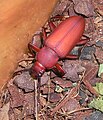
Polystyrene (PS) is a synthetic polymer made from monomers of the aromatic hydrocarbon styrene. Polystyrene can be solid or foamed. General-purpose polystyrene is clear, hard, and brittle. It is an inexpensive resin per unit weight. It is a poor barrier to air and water vapor and has a relatively low melting point. Polystyrene is one of the most widely used plastics, with the scale of its production being several million tonnes per year. Polystyrene is naturally transparent, but can be colored with colorants. Uses include protective packaging, containers, lids, bottles, trays, tumblers, disposable cutlery, in the making of models, and as an alternative material for phonograph records.

Mealworms are the larval form of the yellow mealworm beetle, Tenebrio molitor, a species of darkling beetle. Like all holometabolic insects, they go through four life stages: egg, larva, pupa, and adult. Larvae typically measure about 2.5 centimetres (0.98 in) or more, whereas adults are generally 1.25 to 1.8 centimetres in length.

Darkling beetle is the common name for members of the beetle family Tenebrionidae, comprising over 20,000 species in a cosmopolitan distribution.

Waxworms are the caterpillar larvae of wax moths, which belong to the family Pyralidae. Two closely related species are commercially bred – the lesser wax moth and the greater wax moth. They belong to the tribe Galleriini in the snout moth subfamily Galleriinae. Another species whose larvae share that name is the Indian mealmoth, though this species is not available commercially.

Tenebrio obscurus, or the dark mealworm beetle, is a species of darkling beetle whose larvae are known as mini mealworms. These insects should not be confused with younger mealworms or with the confused flour beetle.

Live food is living animals used as food for other carnivorous or omnivorous animals kept in captivity; in other words, small preys fed alive to larger predators kept either in a zoo or as a pet.

Zophobas is a genus of beetles in the family Tenebrionidae, the darkling beetles. In Cuba beetles of this genus are known as blind click-beetles.
Giant mealworm can refer to:

Flour beetles are members of several darkling beetle genera including Tribolium and Tenebrio. They are pests of cereal silos and are widely used as laboratory animals, as they are easy to keep. The flour beetles consume wheat and other grains, are adapted to survive in very dry environments, and can withstand even higher amounts of radiation than cockroaches. They are a major pest in the agricultural industry and are highly resistant to insecticides.

Tenebrioninae is the largest subfamily of the darkling beetles (Tenebrionidae), containing flour beetles, among others. Tenebrioninae contains more than 20 tribes.
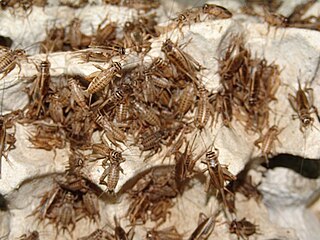
Insect farming is the practice of raising and breeding insects as livestock, also referred to as minilivestock or micro stock. Insects may be farmed for the commodities they produce, or for them themselves; to be used as food, as feed, as a dye, and otherwise.
Scarabiasis, or "beetle-disease", is a condition where beetles temporarily infest the digestive tract of other animals. It can also affect humans, and despite being a rare phenomenon, it is the second most important insectal disease in humans after myiasis, which is caused by the larva of flies. The term is commonly used as a synonym of canthariasis, but the latter refers to the infection of animal tissues by beetle larva, whereas the Scarabiasis refers to the infection by adult beetles. Moreover, Scarabiasis refers to the passing of live beetles in animal faeces. Reported symptoms of scarabiasis include loss of appetite, diarrhea, abdominal cramps, vomiting, nausea, and insects in stool. Scarabiasis has been known to infect the gastrointestinal tract, urogenital system, nasal sinuses, ears, and faces of mammals and other animals.

Insects as food or edible insects are insect species used for human consumption. Over 2 billion people are estimated to eat insects on a daily basis. Globally, more than 2,000 insect species are considered edible, though far fewer are discussed for industrialized mass production and regionally authorized for use in food. Many insects are highly nutritious, though nutritional content depends on species and other factors such as diet and age. Insects offer a wide variety of flavors and are commonly consumed whole or pulverized for use in dishes and processed food products such as burger patties, pasta, or snacks. Like other foods, there can be risks associated with consuming insects, such as allergic reactions. As commercial interest in insects as food grows, countries are introducing new regulatory frameworks to oversee their production, processing, marketing, and consumption.

Alphitobius diaperinus is a species of beetle in the family Tenebrionidae, the darkling beetles. It is known commonly as the lesser mealworm and the litter beetle. It has a cosmopolitan distribution, occurring nearly worldwide. It is known widely as a pest insect of stored food grain products such as flour, and of poultry-rearing facilities and it is a vector of many kinds of animal pathogens. In larval form, it is an approved novel food in the European Union, and also used as animal feed.
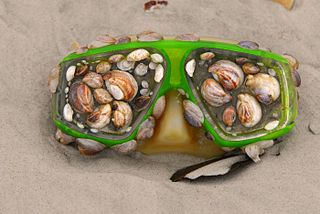
The plastisphere consists of ecosystems that have evolved to live in human-made plastic environments. All plastic accumulated in marine ecosystems serves as a habitat for various types of microorganisms, with the most notable contaminant being microplastics. There are an estimate of about 51 trillion microplastics floating in the oceans. Relating to the plastisphere, over 1,000 different species of microbes are able to inhabit just one of these 5mm pieces of plastic.

Asbolus verrucosus(LeConte, 1852), also known as the desert ironclad beetle or blue death feigning beetle, is a species of darkling beetle native to southwestern United States and northwestern Mexico, where it inhabits dry, sandy habitats such as the Sonoran and Mojave Deserts. It is highly adapted to hot environments and is omnivorous, consuming dead insects, fruits, lichen, and other plant matter. When threatened, the beetles are able to feign death. The species is becoming increasingly popular in the pet trade, due to their ease of care, hardiness, and longevity.

Tenebrio is a genus of darkling beetles. Adults are 12–18 mm (0.47–0.71 in) long and can live for 1–2 years. The larvae are minor pests, but they are also widely reared and sold as pet food.
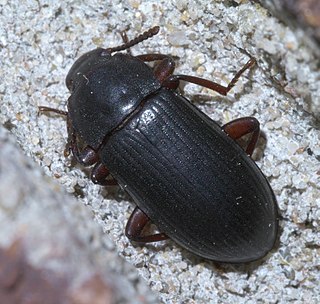
Tenebrionini is a tribe of darkling beetles in the family Tenebrionidae. There are at least 20 genera in Tenebrionini.
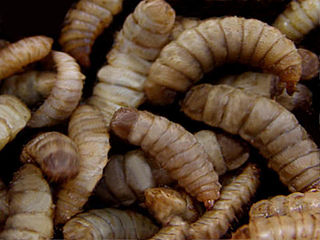
Insects as feed are insect species used as animal feed, either for livestock, including aquaculture, or as pet food.

A plastivore is an organism capable of degrading and metabolising plastic. While plastic is normally thought of as non-biodegradable, a variety of bacteria, fungi and insects have been found to degrade it.

